Download PDF
Download page Global Editors.
Global Editors
Global Editors can be used to quickly edit information for all subbasins and reaches instead of editing individual element Component Editors. Basin Model parameters can be edited globally from the Parameters menu. Global Editors allow the user to edit element parameter values individually or in bulk. Values can be transferred to and from tabulated data spreadsheets through simple copy and paste functions. The user can calculate values based on physical subbasin characteristics or imported grid data for models that have been georeferenced. The user can also filter data and sort elements.
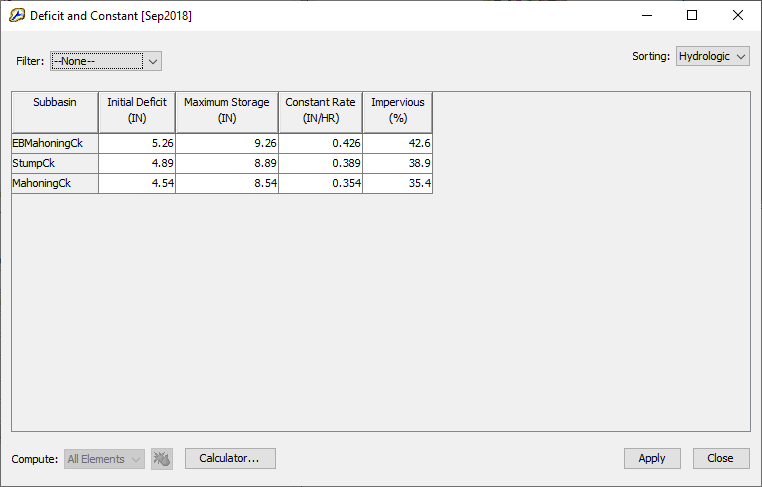
Opening the Global Editor
Select the Basin Model you wish to edit from the Watershed Explorer | Components tab. Click on the Parameter menu and select the Parameter Type. Upon selecting a parameter to globally edit, a list of available Methods for computing that parameter will be listed. The method(s) currently in use within your Basin Model will be displayed in bolded text and unused methods will be greyed out. There will also be an option listed to Change Method which allows you to change the method for all Basin Model elements or for only the individual element selected from the Component tab. Both Subbasin and Reach parameters can be edited from the Global Editor.
Menu options reflect the selected basin model elements. For example, if a junction element is selected in the basin model then all Loss method menu options will be greyed out. You would need to unselect the junction element before attempting to open a loss global editor.
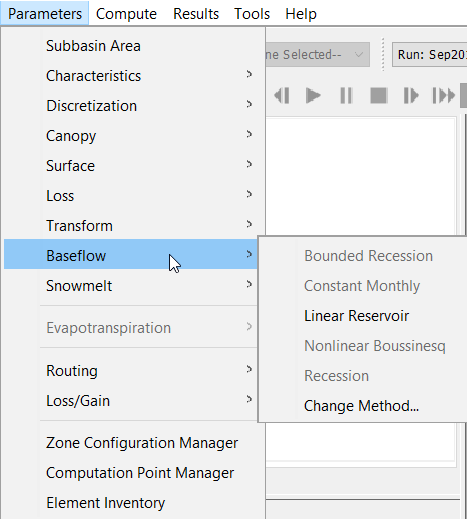
Subbasin Parameters:
- Discretization
- Canopy
- Surface
- Loss
- Transform
- Baseflow
- Snowmelt
- Evapotranspiration
Reach Parameters:
- Routing
- Loss/Gain
Filter the Element List
In the Global Editor dialog box, the Filter dropdown menu allows you to display elements based on Computation Point or Zone groupings you have previously designated. Click on the Filter dropdown menu. If hydrologic elements are selected when opening a global editor then Initial Selection will be listed along with Computation Point, Zone, and None. Select None to display all elements and remove any filters.
Select Filter | Computation Point to filter by computation point. A second dropdown menu will appear with a list of Computation Points. Select the desired computation point to filter for only reach or subbasin elements located upstream of that point.
Select Filter | Zone to filter by zone. Two additional dropdown menus will appear. The first dropdown menu will list Configuration options. Select the desired configuration from the Configuration dropdown menu. The second dropdown menu will list Zone options. Select the desired zone from the Zone dropdown menu to filter for only elements assigned to that zone.
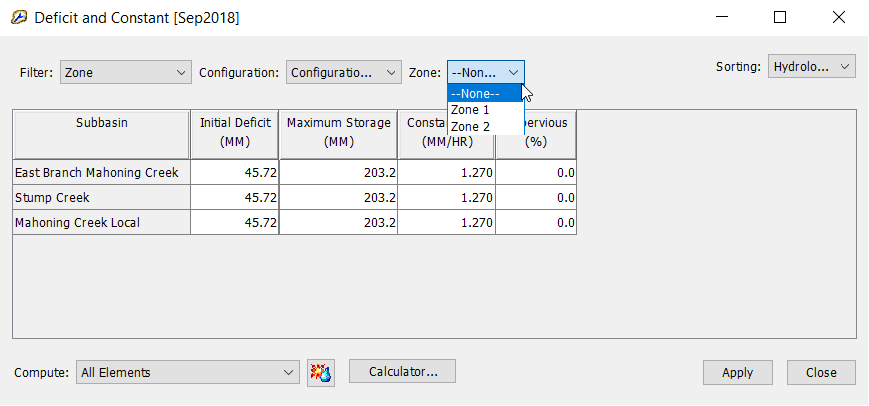
Sorting the Element List
In the Global Editor dialog box, the Sorting dropdown menu allows you to display elements sorted Alphabetically (A to Z) or Hydrologically, from upstream to downstream. The hydrologic order is determined by the element's proximity to the most downstream point, which HEC-HMS will recognize as the outlet. To sort basin or reach elements by hydrologic order, select Hydrologic from the Sorting dropdown menu. To sort basin or reach elements in alphabetic order, select Alphabetic from the Sorting dropdown menu.
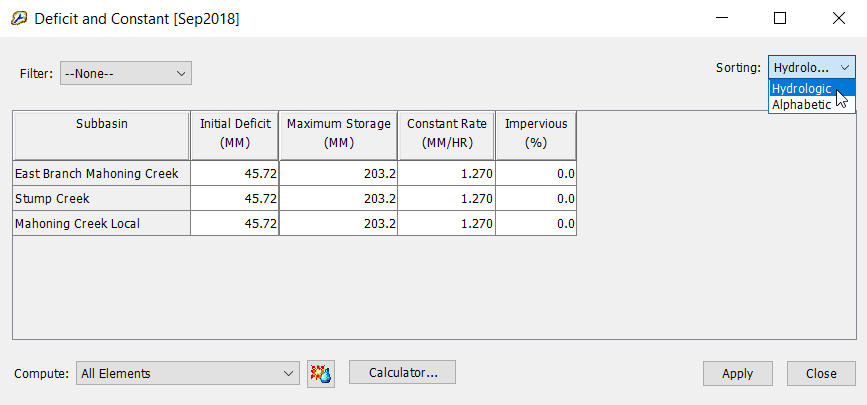
Manually Editing Global Editor Table
Values in the Global Editor table can be copied and pasted in for entire columns and rows or for only those cells selected by the user. Click and drag your mouse to highlight the cells for which you want to copy in values and hit CTRL+V on the keyboard or right click and select Paste. HEC-HMS has some additional built-in tools to edit selected cells. Right click within the first selected row and select Fill. A variety of options will appear in the Table Fill Options dialog in a separate window. Use the radio buttons to select the fill option you want to use. Click OK and the fill operation will be applied to any selected cells in the Global Editor table. Any updated values will appear highlighted in blue until applied.
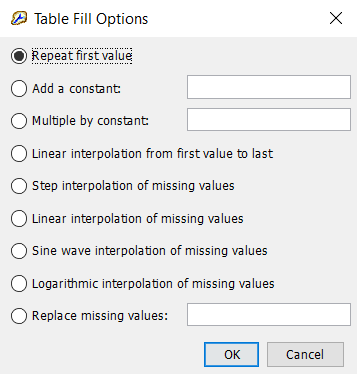
Calculator
The Global Editor dialog includes a Calculator function. The Calculator function allows you to calculate parameters based on internal variables of physical watershed properties or user-imported gridded data. Click the Calculator button and the Expression Calculator dialog box will open in a separate window.
Select the Parameter that you wish to calculate in the Field dropdown box in the Expression Calculator dialog. The selected parameter will appear above the Expression window as the left side of the mathematical expression as <Selected Parameter> =. The Variables window displays a list of available variables that you can use in your expression. There are two tabs in the Variables window, Grids and Stats. In the Grids tab is a list of user-imported gridded data. The Calculator uses a spatially averaged value for the grid cells that fall within the bounds of each subbasin. The Stats tab displays a list of variables based on the physical properties of your watershed's subbasin or reach elements. Double-click on a Grid or Stats variable to add it to the Expression window. The Functions window displays a list of Visual Basic (VBA) math functions that you can use in your expression. Below the functions window is a row of arithmetic operator buttons including multiplication (*), division (/), addition (+), subtraction (-) and string concatenation (&). For more information on the Expression Calculator, see Parameter Estimation.
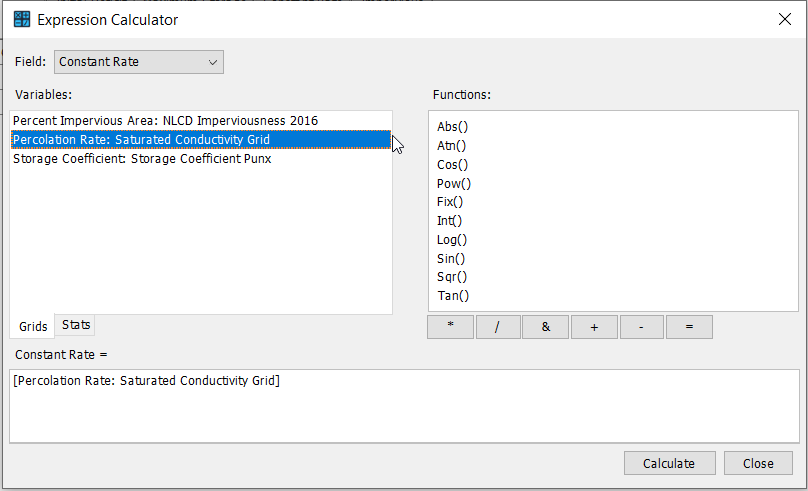
Once the expression is complete. Click Calculate. The value of the selected parameter will be updated in the Global Editor dialog and highlighted in blue. Click Close to close the Expression Calculator dialog window and return to the Global Editor dialog window.
Applying Edits
Values updated in the Global Editor table either manually, computed in the Expression Calculator, or copied in will be highlighted in blue. This indicates that these values are not saved or applied within the model. Click Apply to save edits to parameter values and parameter values will change back to the default black text within the table.
Computing from Global Editor
Simulation Runs can be computed directly from the Global Editor dialog window. Select the desired Simulation Run from the Current Simulation Run dropdown menu. Select Compute | All Elements and click the Compute button within the Global Editor dialog to compute results for the entire Basin Model and all associated elements. In large complex models, it can be useful to compute isolated sections of the model. Select the desired computation point from the Compute dropdown menu. This approach to computing results can save time by not performing any calculations downstream of the selected computation point. A window will automatically open that shows the progress of the compute.
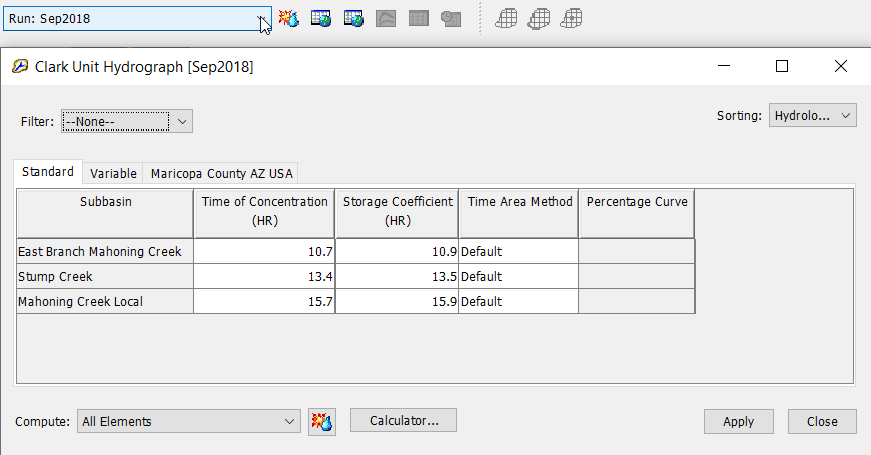
Exporting Values from Global Editor Table
Highlight cells by clicking and dragging to select cells you wish to copy out. Hit CTRL+V on the keyboard or right click and select Copy. These cells will be copied to your clipboard and can be pasted into a table external to the HEC-HMS program. The Global Parameter table can also be exported as a text file. Highlight the cell you wish to export, right click, and select Export. To include table headings, click the Include column labels box. The output text file will default to the model directory. Select the Browse button on the Table Export Options to select a different folder directory and rename the output text file.
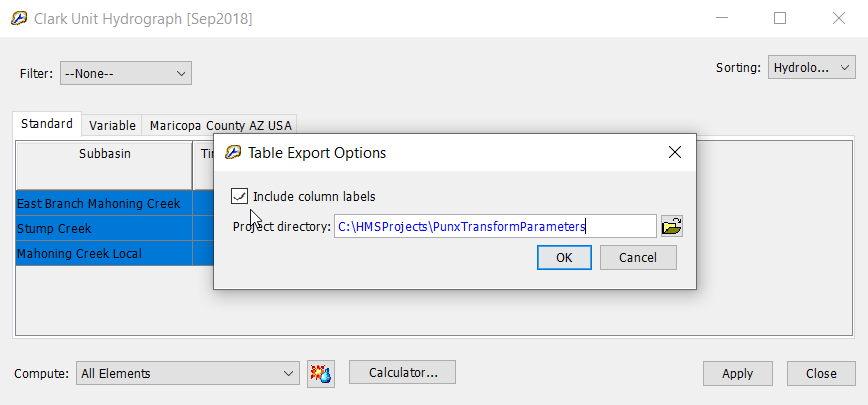
Closing the Global Editor
When desired updates have been successfully applied, click Close to close the Global Editor dialog window.